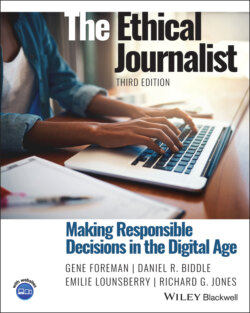Читать книгу The Ethical Journalist - Gene Foreman - Страница 59
Guidelines for Intervention
ОглавлениеSo, when do you stop reporting and get involved in the story? The answer to this question – and many other ethical questions presented in this book – is: “It depends.” Every situation is different. There are no absolute answers.
Even so, you will benefit from the framework of guidelines to help you make your decision in a rational way. Note the word guidelines. Not rules.
Over the years, journalism practitioners and scholars have reached a consensus guideline: A journalist should act to save a life or prevent injury if he or she is the best person or the only person in a position to intervene.
Amplifying that guideline, Bob Steele of Poynter outlined a four-question process:
1 Is the danger imminent?
2 Is the danger profound?
3 Is there anyone else present who can help?
4 Do you, the journalist, possess special skills needed in the situation?
To illustrate, Steele offered a hypothetical example: You arrive after a car has gone off a bridge and into the river. It is about to sink. Thus the answers to questions 1 and 2 are yes – there is imminent danger, and it is profound.
If paramedics and divers are already in action, the answer to question 3 is yes – others on the scene are in a better position to help. You can do your journalist’s job in good conscience, shooting pictures and gathering facts.
But the situation changes if the answer to question 3 is no. If you’re the only one at the scene or there are only a few others, you might go into the river to attempt a rescue. But only if you’re an expert swimmer. In that case the answer to question 4 is yes: you possess the special skill desperately needed in this situation. If you are not a skilled swimmer, to try to make a rescue would likely be futile and perhaps suicidal. You still have a duty to intervene, and you do so by summoning help.31
As useful as the guideline and Steele’s questions are in framing the decision‐making, the journalist may still need to make a dire judgment call. This can be especially painful if the judgment involves a medical decision that the journalist is technically unqualified to make. For example, in the first of two case studies accompanying this chapter, “The Journalist as a Witness to Suffering,” the reporter had to decide whether the girl’s fever from the spider bite was serious enough to warrant stepping out of her journalist role to drive her to hospital.
In the second case study, “Journalist Is Beaten; Reporter Steps In,” Al Letson had to decide whether to continue reporting on a street brawl between two groups of demonstrators, or to try to save someone being assaulted. Whether or not he was “the best person or the only person,” he could see that no one else was intervening.
Rachel Smolkin, who wrote about journalists who intervened in Katrina’s aftermath, offers this guidance:
Follow your conscience. Your humanity – your ability to empathize with pain and suffering, and your desire to prevent it – does not conflict with your professional standards. Those impulses make you a better journalist, more attuned to the stories you are tasked with telling.
If you change an outcome through responsible and necessary intervention because there’s no one else around to help, so be it. Tell your bosses, and when it’s essential to a story, tell your readers and viewers, too.
Remember, though, that your primary – and unique – role as a journalist is to bear witness. If you decide to act, do so quickly, then get out of the way.32
